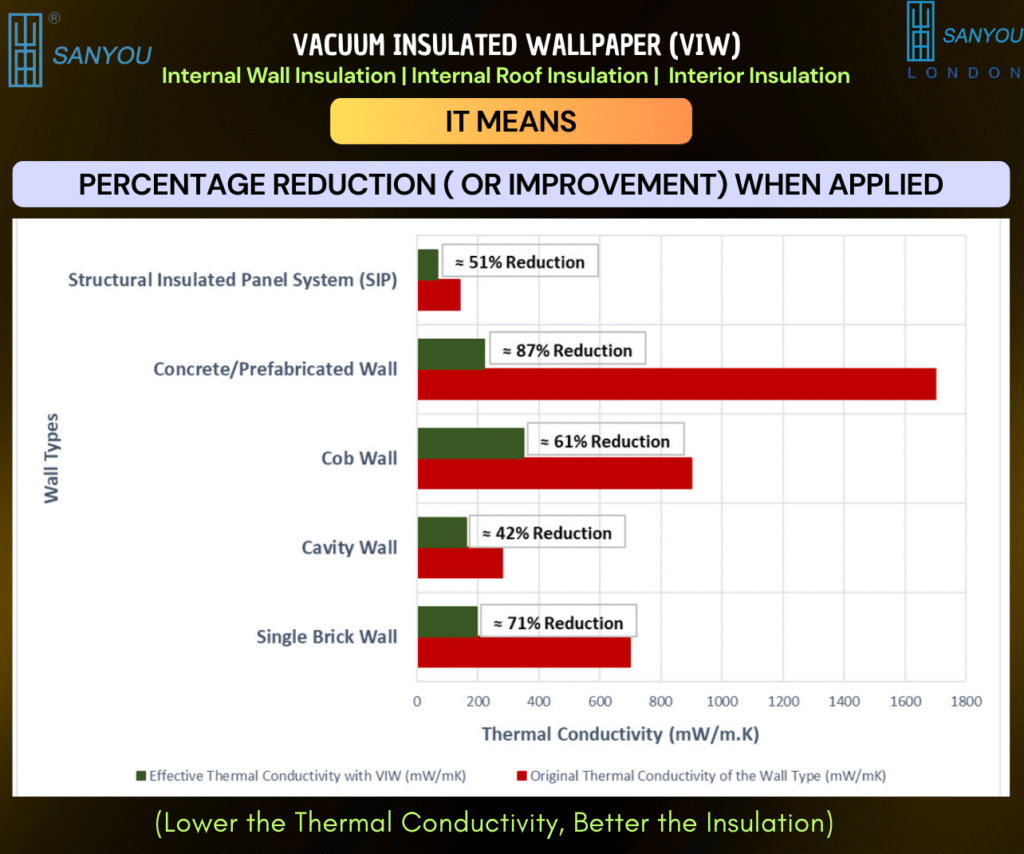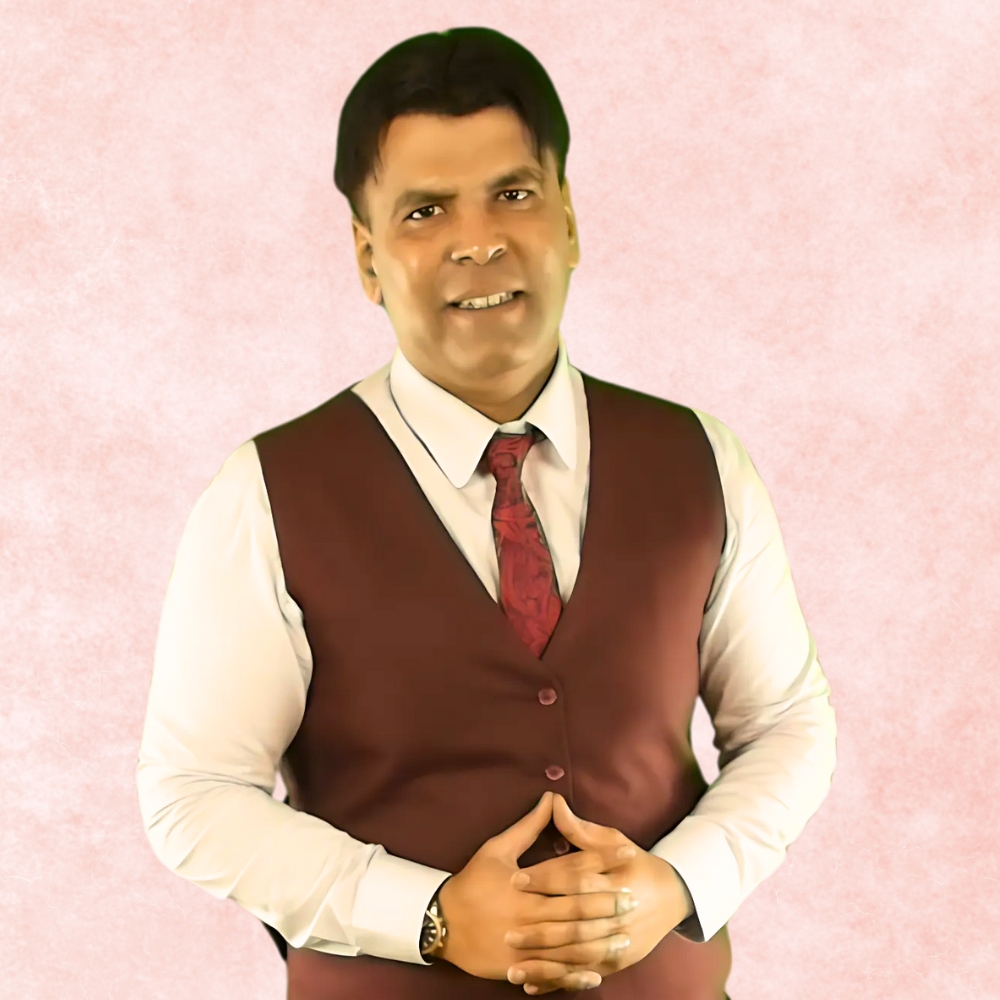
4 mm VIW: conductivity, thickness—and what it really changes on real walls
Homeowners often hear two numbers and wonder which matters most: thermal conductivity and U-value. Conductivity is the material’s own measure; U-value describes the heat that escapes through a whole layer or wall. Lower is better for both. With Vacuum-Insulated Wallpaper (VIW) we optimise the first number so an ultra-thin layer can still move the second one decisively when it is added to an existing wall.
The headline: what 4 mm VIW brings to the table
VIW is invented by Professor Saim Memon with a reason to bring down your Energy Bills.
- Thickness: 4 mm total.
- Conductivity (λ): about 0.005 W/m·K (5 mW/m·K)—exceptionally low for any building product.
- Design U-value (stand-alone sheet): about 1.3 W/m²·K—a natural consequence of being very thin.
- Format: modular 200 × 200 mm tiles; custom shapes; finished face ready for interiors.
Why this combination works: conductivity this low means you do more with every millimetre you add. On a bare wall, 4 mm alone cannot reach a very low U-value—but as a high-performance lining on an existing structure it shifts the composite performance significantly, and it does so without stealing floor space or triggering messy works.
Conductivity snapshot—VIW against familiar products
(Conductivity is a property of the material itself; it does not improve by simply making it thicker.)
- VIW (4 mm): λ ≈ 0.005 W/m·K
- Thermal insulating wallpaper (10 mm class): λ ≈ 0.074 W/m·K
- Wallrock thermal liner (≈4 mm): λ ≈ 0.050 W/m·K
- Rock mineral wool (reference 250 mm boards): λ ≈ 0.034 W/m·K
- Glass mineral wool (200 mm): λ ≈ 0.044 W/m·K
- PIR rigid board (180 mm): λ ≈ 0.022 W/m·K
- EPS (100 mm): λ ≈ 0.036 W/m·K
Reading this correctly: bulk products hit low U-values by being thick. VIW contributes a very low-conductivity layer that upgrades what you already have, in millimetres instead of centimetres.
Composite impact on common wall types
Using the same 4 mm VIW lining and consistent boundary assumptions, our programme testing shows the following reductions in effective thermal conductivity of the overall wall build-up:
- Structured Insulated Panel (SIP): about 51% reduction
- Concrete or prefabricated wall: about 87% reduction
- Cob wall: about 61% reduction
- Unfilled cavity wall: about 42% reduction
- Single solid brick wall: about 71% reduction
In plain terms: add VIW and the wall leaks less heat in winter and admits less heat in summer. That means smaller bills, fewer hard restarts after thermostat setbacks, and rooms that feel calmer.

What “thin but effective” means for day-to-day comfort
- Warmer internal surfaces: lining lifts the wall’s inside face closer to room temperature, reducing that “cold-radiation” feeling at sofas and bed heads.
- Fewer condensation streaks: warmer surfaces are less likely to hit dew-point in corners and behind furniture.
- Steadier summer rooms: west-facing or sun-soaked walls admit heat more slowly, softening late-afternoon spikes.
- No space penalty: skirtings, sockets and furniture usually remain where they are; floor plans do not shrink.
Where 4 mm VIW is the smarter choice than thick boards
- Flats and terraces where every millimetre counts and leasehold rules restrict invasive works.
- Heritage interiors where proportions and mouldings must stay readable.
- Quick wins during a cost-of-living squeeze: treat the coldest wall first and feel an immediate difference.
- Pre-sale upgrades where improved comfort and visible finish help a listing stand out while supporting a stronger EPC.
Project sketches you can actually use
- SIP extension: clients love the speed but often complain of summer heat gain. VIW on sun-struck internal faces trims the swing without changing the set-out.
- Concrete-frame flat: a north gable feels chilly even at 20 °C. VIW lifts surface warmth and reduces the temptation to over-heat the room.
- Cob cottage: sensitive fabric; intrusive lining is a non-starter. VIW offers a minimal, reversible layer that still moves the needle.
- 1950s cavity-wall semi: treat the cold living-room wall behind the sofa; pair with heavy curtains for the glazing; comfort improves at the same thermostat point.
How to specify VIW clearly
- State the target: wall type and the rooms to prioritise (by comfort complaint or meter data).
- Declare the layer: “Vacuum-Insulated Wallpaper (VIW), 4 mm, declared conductivity about 0.005 W/m·K, modular 200 × 200 mm tiles with finished face.”
- Continuity at edges: include returns into short window reveals and chimney-breast wings to avoid bypass paths.
- Services: order pre-cut pieces for sockets and switches—do not cut or drill the tiles on site.
- Moisture: treat sources of damp first; VIW is for thermal performance, not for masking moisture ingress.
Verifying the benefit—simple homeowner tests
- Thermal imaging on a cold evening before and after lining; expect a warmer, more uniform tone on treated walls.
- Plug-in energy logger on portable heaters; track runtime before and after in the same weather band.
- Comfort notes: record perceived draught and cold-wall sensation at usual seating; most households report immediate improvement.
Fair limits and good practice
- VIW is not a fire shield or structural element; treat it as a high-performance lining.
- Adhesion and longevity depend on a sound, primed surface; poor prep is the enemy of any thin system.
- As with any insulation, the whole wall—including junctions—sets the outcome. Our continuity details matter.
Ready to see what 4 mm can do on your walls?
Speak with our Customer Service Team for a quick area take-off, a room-by-room proposal, and a tailored price quotation. You can explore full specifications, FAQs, and how-to videos at www.sanyoulondon.com.
If you prefer a direct technical conversation, you are most welcome to contact Professor Saim Memon by email or phone. We will review photos or drawings and advise where VIW delivers the greatest return first.
Bottom line: with VIW (Sanyou London) you add a tiny layer that makes a big difference—measurable reductions in heat loss and real improvements in comfort, without builders, scaffolds or lost floor area.
Share

Author
Prof. Dr. Saim Memon
PhD, CEng, FHEA, MSc, BEng(Hons), PGC-TQFE, GTCS, MCMI, MIET, MIEEE, MInstP, IBPSA, APCBEES, MPEC
CEO | Industrial Professor | Inventor | British Scientist | Chartered Engineer | Qualified Teacher | Chief Editor | World Speaker | Pioneer in Vacuum Insulation Energy Technologies

